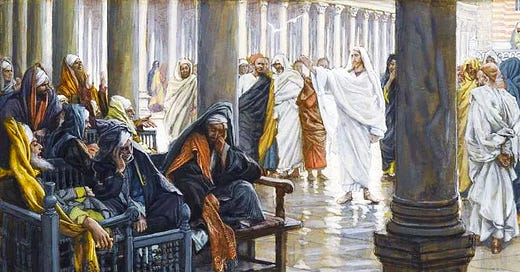‘Woe Unto You’: Why Jesus Confronted the Pharisees
SCRIPTURES & ART: A look at the readings for the 31st Sunday in Ordinary Time, through the eyes of 19th-century French artist James Tissot
John Grondelski - NOV 4, 2023
For the past several weeks, Matthew’s Gospel has been unrelenting in his attacks on the Pharisees. They are presented as faithless husbandmen in a vineyard they try to seize for their own. They are portrayed as insincere interlocutors who question Jesus, not to learn but to catch him in his words. They are invited guests who can’t be bothered to honor the invitation. All those criticisms are summed up in today’s Gospel.
Jesus unloads with both barrels. The Pharisees might be good in what they teach, but not in their example: listen to their words, disregard their example. “Observe all things they tell you, but do not follow their example.” Why? Because “they preach but do not practice.” They are experts at what others need to do, not brothers to bear the burden: “They tie up heavy burdens, hard to carry, and lay them on people’s shoulders, but will not lift a finger to move them.”
In essence, it’s all an act, first-century virtue signaling: “All their works are performed to be seen.” Jesus then singles out six examples:
ostentatious religious garb (Tefillin, or phylacteries, are small boxes with Scriptural texts in them that orthodox Jews attach by means of leather bands to their heads and forearms during prayer. Tzitzit, or tassels, are fringes on prayer shawls);
prime seating (top tables at banquets, places of honor in synagogues. Jesus pokes fun at their competition for tables in his lessons on humility: see Lk 14:7-11;
public salutations and honorific titles (“rabbi” means “teacher,” a master of the Law — Torah).
Pope St. Paul VI recognized what Jesus is talking about in one of his most memorable quotations from his 1975 Apostolic Exhortation, Evangelii Nuntiandi: “Modern man listens more willingly to witnesses than to teachers, and if he does listen to teachers, it is because they are witnesses” (no. 41).
Now the tension between speaking and doing are challenges, because all of us are sinners. All of us fall short, in one way or another, of what we should be, much less what we profess to be. That dissonance — that hypocrisy — alienates people. Vatican II, for example, blames atheism on two sources: those who are ideologically committed to it as well as on “practical atheists,” i.e., people who profess to be Christian but whose lives are anything but.
Yet the truth must be spoken, and that also involves being spoken by those who fall short of that truth. How to handle that split? First, be humble: to recognize one’s failing the mark and to work toward reaching it. Second, pray and strive for “authenticity.”
In his philosophical writings, the American ethicist Germain Grisez at one point named “authenticity” among the eight basic human goods. Authenticity was one of four goods that progressively connected the human person within himself, with the outside world, with others, and with God. Authenticity specifically affected relating the interior person and the outside world, a kind of transparency: what you see is what you get, what is behind it all. The man inside and the man the world sees are one and the same.
That’s what Jesus asks for, and that’s why he excoriates the Pharisees. It’s not even just that they fell short. It’s that they refused to see the deficit.
Today’s Gospel is illustrated in art by our favorite 19th-century French religious artist, James (Jacques) Tissot (1836-1902). “Malheur à vous, scribes et pharisiens” (“Woe unto You, Scribes and Pharisees”) is part of his larger “Life of Christ” series, watercolor (gouache) on paper, which he worked on from 1886-94. He had visited the Holy Land to reinforce the fidelity of his works. (The series is held by the Brooklyn Museum, though not — like this painting — on view.) It is a small painting: 10 x 6 inches.
The very layout of the painting is confrontational: Jesus versus the Pharisees. Jesus (in the characteristic white that is always Christ in Tissot) stands, right hand raised, against a crowd of about nine Pharisees, all reclining in dark colors on “chair[s] of Moses.” Jesus looks them straight in the eye. Compare that to the Pharisee closest to Jesus, almost in the middle of the painting, who averts his gaze. The other two to his right do likewise: most of the rest stare back with clear hostility. The gaze of some suggests, “Not this guy again!” If there are any guilty consciences in that crowd, it doesn’t show: while averting one’s eyes might be an unconscious sign of recognizing the problem, their facial expressions largely express more obstinance than self-examination.
The confrontation occurs in the Temple, with Jesus in the open-air portico, while the Pharisees occupy their established perches. Perhaps some of those to Jesus’ right are his disciples. Past the first column on the right, we see onlookers taking in the conflict.
The viewer’s vantage point lets him see both parties, but also causes him to ask: On which side am I?
In the next three weeks, the Church’s Gospel focus will shift to the end times: death, judgment, heaven, hell. Before we go there, however, it’s worth considering the message of today’s Gospel: Who is the man I bring before God’s judgment seat? And is what you see what you get?
***
John M. Grondelski (Ph.D., Fordham) is former associate dean of the School of Theology, Seton Hall University, South Orange, New Jersey. He is especially interested in moral theology and the thought of John Paul II. [Note: All views expressed in his National Catholic Register contributions are exclusively the author’s.]
https://www.ncregister.com/blog/scriptures-and-art-year-a-31st-sunday-pharisees





